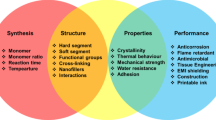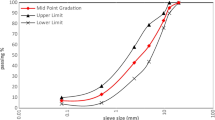Abstract
Polyphosphoric acid (PPA) was used to improve the physical and rheological properties of high-viscosity modified (HVM) asphalt and decrease the styrene–butadiene–styrene (SBS) content. The sample preparation technique was optimized further by blending furfural extract oil and asphalt in advance. With the optimized preparation process, the major physical and rheological properties of HVM asphalt were improved further by adding the same amount of PPA comparing with other preparation processes; however, the motive viscosity, toughness and tenacity of HVM asphalt still depended on the SBS content. Various rheological tests were adopted to investigate the effect of PPA on the rheological behaviours of HVM asphalt before and after ageing. The suitable gelation accused by PPA not only improved the high-temperature rheological performances of HVM asphalt, but increased the low-temperature rheological performances. Morphology observation by using optical microscope showed the effect of vulcanization and ageing on the outline and distribution of SBS in HVM asphalt. Fourier transform infrared analysis indicated the difference of SBS content under different modifications. Thermal analysis displayed the effect of PPA on the thermodynamic behaviours of HVM asphalt and demonstrated the declined ageing susceptibility of HVM asphalt after PPA modification.










Similar content being viewed by others
References
Liang YJ, Xu ZH. Performance evaluation of high viscosity modified asphalt. Pet Asph. 2010;24:20–2 (Chinese).
Tan YQ, Shi KL, Wang JN, Gong WQ. Research on the impact of asphalt character on stress absorbing layer performance. J Highw Transp Res Dev. 2009;26(2):13–7 (in Chinese).
Xu B. The theory and practice of porous asphalts. 1st ed. Beijing: China People Communication Press; 2011.
Mark B. Polyphosphoric acid modification of asphalt. Asphalt. 2005;20:38–40.
Bonemazzi F, Giavarini C. Shifting from sol to gel. J Pet Sci Eng. 1999;22:17–24.
Yan KZ, Zhang H, Xu HB. Effect of polyphosphoric acid on physical properties, chemical composition and morphology of bitumen. Constr Build Mater. 2013;47:92–8.
Martin JV. Polyphosphoric acid use in asphalt more than 40 years experience. Asphalt. 2006;21:14–6.
Xiao FP, Amirkhanian S, Wang HN, Hao PW. Rheological property investigations for polymer and polyphosphoric acid modified asphalt binders at high temperatures. Constr Build Mater. 2014;64:316–23.
Martin J, Hampl R, Otakar V, Dusan B, Jiri S, Ludovit Z. Rheology of conventional asphalt modified with SBS, Elvaloy and polyphosphoric acid. Fuel Process Tech. 2015;140:172–9.
Javier Y, Mahecha N, Matheus D, Inocente D, Adalberto LF. Susceptibility of low-density polyethylene and polyphosphoric acid-modified asphalt binders to rutting and fatigue cracking. Constr Build Mater. 2014;73:509–14.
Liang P, Liang M, Fan WY, Zhang YZ, Qian CD, Ren SS. Improving thermo-rheological behavior and compatibility of SBR modified asphalt by addition of polyphosphoric acid (PPA). Constr Build Mater. 2017;139:183–92.
Zhang F, Yu JY. The research for high-performance SBR compound modified asphalt. Constr Build Mater. 2010;24:410–8.
Zhang F. Studies on the modified asphalt with phosphorus compounds and its rheological properties. Master dissertation, Northwest Normal University, Lanzhou City, China, 2008.
Zhang F, Hu CB. The research for SBS and SBR compound modified asphalts with polyphosphoric acid and sulfur. Constr Build Mater. 2013;43:461–4.
Zhang F. Influence of polyphosphoric acid and sulfur on ageing properties of rubber-modified asphalts. Doctor dissertation, Wuhan University of Technology, Wuhan City, China, 2011.
Linda M. US patent 99/58600, 1998.
Willamson PO. US patent 06414056B1, 2002.
Zhang F, Hu CB. The composition and ageing of high-viscosity and elasticity asphalts. Polym Compos Online. 2017;38:2509-2517.
Zhang F, Hu CB. Preparation and properties of high viscosity modified asphalt. Polym Compos. 2017;38:936–46.
Zhang F, Hu CB, Zhuang WL. The research for low-temperature rheological properties and structural characteristics of high-viscosity modified asphalt. J Therm Anal Calorim Online. 2018;131(2):1025–35.
Liu XL. Preparation and properties of high viscosity modified asphalt. Master Thesis, Wuhan University of Technology, Wuhan City, China, 2008.
Lu X, Isacsson U. Rheological characterization of styrene-butadiene-styrene copolymer modified bitumens. Constr Build Mater. 1997;11:23–32.
Bahia HU, Hanson DI, Zeng M, Zhai H, Khatri MA, Anderson RM. Characterization of modified asphalt binders in superpave mix design. Natl Coop Highw Res Program Rep 2001;459.
Hu RY, Bahia HU, Zhai Z, Zheng M. Measuring resistance of asphalt binders to permanent deformation using the DSR device. In: TRB 80th annual meeting, Washington; 2001.
Binard C, Anderson D, Lapalu L, Planche JP. Zero shear viscosity of modified and unmodified binders. In: Proceeding of the 3rd Eurasphalt and Eurobitume congress, Vienna; 2004.
Zhang F, Hu CB. The research for high-elastic modified asphalt. J Appl Polym Sci. 2015;132:42134(1)–14).
Ouyang CF, Wang SF, Zhang Y, Zhang YX. Improving the aging resistance of styrene–butadiene–styrene tri-block copolymer modified asphalt by addition of antioxidants. Polym Degrad Stab. 2006;91:795–804.
Lamontagne J, Dumas P, Mouillet V, Kister J. Comparison by Fourier transform infrared (FTIR) spectroscopy of different ageing techniques: application to road bitumens. Fuel. 2001;80:483–8.
Zhang F, Hu CB. The research for structural characteristics and modification mechanism of crumb rubber compound modified asphalts. Constr Build Mater. 2015;76(1):330–42.
Juan M, Jiménez M, Luis CQ, Carmen R. Characterization of petroleum bitumens and their fractions by thermogravimetric analysis and differential scanning calorimetry. Fuel. 1996;75:1691–700.
Radhakrishnan CK, Sujith A, Unnikrishnan G. Thermal characterization of asphalt mixtures by TG/DTG, DTA and FTIR. J Therm Anal Calorim. 2008;93:105–9.
Gao JL. Analysis and evaluation of bitumen new index and additive index. Doctor dissertation, Southeast University, Nanjing City, China, 2005.
Acknowledgements
This research was supported by the foundation of Fujian Education Department (CN), and the fund number is JAT160060.
Author information
Authors and Affiliations
Corresponding author
Rights and permissions
About this article
Cite this article
Zhang, F., Hu, C. & Zhang, Y. The effect of PPA on performances and structures of high-viscosity modified asphalt. J Therm Anal Calorim 134, 1729–1738 (2018). https://doi.org/10.1007/s10973-018-7740-7
Received:
Accepted:
Published:
Issue Date:
DOI: https://doi.org/10.1007/s10973-018-7740-7




